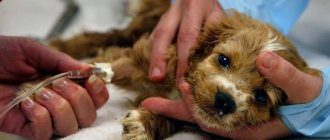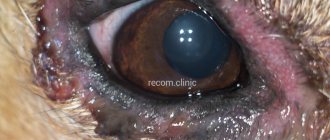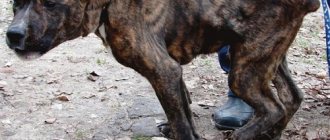Inflammation or vaginitis in dogs: manifestations, how dangerous the disease is, therapy
When pathogenic microorganisms penetrate the vaginal mucosa, dogs often develop an inflammatory process - vaginitis. The disease not only brings physical inconvenience to the animal, but also poses a serious problem for breeders. There are many causes of vaginitis - from hormonal imbalance to mechanical injuries to the external genitalia. The variety of clinical forms of the disease requires competent, qualified assistance.
Read in this article
Diagnosis and treatment
The cause of the disease is determined by clinical symptoms, anamnesis is collected, colposcopy, ultrasound are performed, and smears are taken for bacteriological analysis for sensitivity to antibiotics. Diseases with similar symptoms are excluded, a study is carried out for brucellosis, and the form of vaginitis is determined.
Serous or catarrhal inflammation of the vagina is treated with douching. The following antiseptic agents are used:
The vulva and surrounding areas of the skin are treated with anti-inflammatory wound-healing ointments: Streptocide, Prednisolone, Oxycort, Ichthyol; Tetracycline.
In severe forms of vaginitis, antibiotic therapy is prescribed. The first-choice drugs until the results of a bacteriological study are obtained include the following oral or parenteral drugs:
After deciphering the results of titration for sensitivity to antibiotics, treatment is adjusted. If a fungal etiology of vaginitis is established, external or oral antimycotics are used. The frequency of use of drugs and the duration of treatment are determined by a veterinarian. For hormonal disorders, estrogens are used.
Causes of vaginitis in dogs
Among the reasons for the development of vaginal inflammation in dogs, the key ones, according to veterinary experts, are the following:
- Hormone imbalance. The most common cause of vaginitis in dogs at a young age is hormonal imbalance. For some reason, the internal glands begin to produce a reduced amount of estrogens, which leads to disruption of the proliferation processes in the mucous membrane of the female genital organs. Breeders note that most often vaginitis is observed before the animal’s first estrus, which is due to a hormonal factor.
- Inflammatory diseases of the genitourinary area. Endometritis, cystitis, and inflammation of the uterus often act as chronic foci of infection and lead to vaginitis in animals.
Anatomy of the female genital organs
- Injuries to the external genitalia . Violation of the integrity of the vulva occurs during medical procedures. Incorrect mating of a female (covering a small dog with a large cable) contributes to the formation of microcracks in the mucous membrane.
Mechanical damage to the vagina often occurs during labor, especially during the birth of large puppies, and during obstetrics with non-compliance with the rules of asepsis and antiseptics. Violation of the integrity of the organ mucosa leads to the introduction of pathogenic microorganisms.
- Infection of a female with a sexually transmitted infection during mating or mating of a male. Most often, veterinary specialists encounter vaginitis due to chlamydia, a sexually transmitted disease.
- The use of aggressive drugs for the treatment of endometritis. Violation of the concentration of rinsing solutions, the use of antiseptics not intended for treating the mucous membrane, injure it and lead to inflammation.
According to veterinary experts, the development of vaginitis in dogs is caused by inadequate living conditions and unsanitary conditions. Low immunity and weak body resistance to infections are predisposing factors to the disease.
Causes
Vaginitis in dogs is a disease that affects the genital organs of the animal. It is observed in females of different ages, as well as castrated and nulliparous. The prognosis for a sick animal is most often favorable, and in some cases, vaginitis goes away on its own and without treatment, the owners may not even notice it. However, in order to avoid complications and not reduce the dog’s quality of life, it is better to take timely measures to eliminate this disease.
Mostly young or mature bitches without experience of mating and childbirth suffer from it. Vaginitis is caused by the proliferation of bacteria (staphylococci, E. coli, streptococci, etc.), which are always normally present in the vaginal microflora. An increase in their number is provoked by a decrease in immunity, hormonal imbalance or injuries to the internal genital organs. The latter often appear after a difficult birth or damage from improper actions of people: injuries from palpation of the cervix or when trying to pull out a stuck puppy.
A decrease in immunity has its own reasons - infections, lack of vitamins, poor diet, stress, parasites, hypothermia. Poor hygiene can also cause vaginitis. Hormonal imbalance is observed mainly in bitches before puberty, but even after this period problems with the endocrine system are identified. For example, castrated individuals experience a decrease in estrogen.
Important! Puppies, after weaning from their mother's breast, moving to a new home and during quarantine due to vaccinations, have very unstable immunity. Therefore, they may develop vaginitis due to the slightest hypothermia.
Classification
In veterinary practice, according to the course of the pathological process, it is customary to distinguish between acute and chronic forms of the disease. Depending on the causes and form of inflammation, vaginitis can be juvenile, serous, catarrhal, purulent, fibrous and gangrenous.
Juvenile
Often, clear, creamy vaginal discharge is detected in puppyhood. This type of inflammation is typical for animals that have not reached sexual maturity. The main cause of the disease is hormonal imbalance and metabolic disorders in a growing body.
In modern veterinary medicine, if necessary, the hormonal levels of young animals are corrected with the help of low concentration estrogens. In some cases, juvenile vaginitis goes away on its own without drug therapy.
Catarrhal
The mildest form of inflammation of the vaginal mucosa is catarrhal. The disease is characterized by cloudy, whitish, viscous discharge. With this form of inflammation, a sour, specific smell from the animal is noted, and small ulcers and hemorrhages are observed on the mucous membrane.
The prognosis for catarrhal vaginitis is favorable.
When inflammation is complicated by streptococcal or staphylococcal microflora, catarrhal vaginitis becomes purulent. Yellow-greenish discharge with an unpleasant, pungent odor is observed from the vagina.
Purulent vaginitis
Fibrinous
Fibrinous vaginitis is characterized by the formation of fibrin films, which gives the vaginal secretion a whitish tint. Fibrin plaque accumulates on the surface of the mucous membrane, under which an ulcerative lesion of the organ is detected.
In this regard, veterinary experts do not recommend owners to remove the resulting plaque themselves. With this form of inflammation, the prognosis is cautious.
Gangrenous
The most severe form of the disease is gangrenous vaginitis. The pathological process is accompanied by melting of the mucous membrane under the influence of pyogenic microflora. Not only a modified secretion is released from the vagina, but also pieces of dead tissue. In the gangrenous form of the disease, a sharp putrid odor is observed from the animal. The prognosis may be unfavorable.
About juvenile vaginitis in puppies, watch this video:
Causes
Vaginitis in dogs is a disease that affects the genital organs of the animal. It is observed in females of different ages, as well as castrated and nulliparous. The prognosis for a sick animal is most often favorable, and in some cases, vaginitis goes away on its own and without treatment, the owners may not even notice it. However, in order to avoid complications and not reduce the dog’s quality of life, it is better to take timely measures to eliminate this disease.
Mostly young or mature bitches without experience of mating and childbirth suffer from it. Vaginitis is caused by the proliferation of bacteria (staphylococci, E. coli, streptococci, etc.), which are always normally present in the vaginal microflora. An increase in their number is provoked by a decrease in immunity, hormonal imbalance or injuries to the internal genital organs. The latter often appear after a difficult birth or damage from improper actions of people: injuries from palpation of the cervix or when trying to pull out a stuck puppy.
A decrease in immunity has its own reasons - infections, lack of vitamins, poor diet, stress, parasites, hypothermia. Poor hygiene can also cause vaginitis. Hormonal imbalance is observed mainly in bitches before puberty, but even after this period problems with the endocrine system are identified. For example, castrated individuals experience a decrease in estrogen.
Important! Puppies, after weaning from their mother's breast, moving to a new home and during quarantine due to vaccinations, have very unstable immunity. Therefore, they may develop vaginitis due to the slightest hypothermia.
Symptoms of pathology
Pet owners should closely monitor their dog's health to watch for signs of vaginitis. The disease has the following characteristic signs:
- The dog shows excessive attention to the external genitalia and constantly licks the vaginal loop.
- The nature of the discharge from the external genitalia depends on the form of the disease.
- With the development of purulent and gangrenous vaginitis, an unpleasant putrefactive odor emanates from the animal.
- The general condition is depressed. Often the dog refuses food, or there is a decrease in appetite. The animal lies down a lot, lethargic and inactive.
With purulent, fibrinous and gangrenous vaginitis, intoxication of the body occurs. The animal has an increase in general body temperature.
Prevention
To avoid illness, you need to know preventive measures for your pet.
The following points must be remembered:
- It is necessary to maintain dog hygiene and keep the animal clean;
- The mating of a dog must be carried out with a healthy male, so there is no risk of infection during sexual intercourse;
- It is necessary to maintain a balanced diet;
- Food must contain sufficient amounts of vitamins and microelements;
- It is necessary to monitor the general health and immunity of the animal;
- Timely vaccination can protect against many diseases.
Thus, by observing all of the above preventive measures, the owner will be able to protect his dog from this disease. If the disease is detected early, it can be treated quite easily. It is very important to notice the first symptoms at an early stage, otherwise the disease can lead to serious complications.
Disease prevention
In order to prevent the development of vaginitis in four-legged pets, veterinary specialists and experienced breeders recommend that owners follow the following tips and rules:
- Keep the animal in proper hygienic conditions . The room where the dog is located must be clean, free from drafts and dampness. The litter should be regularly cleaned, washed, and treated with disinfectants.
- A balanced diet is a guarantee of a strong immune system that can resist pathogenic microorganisms. A sufficient amount of vitamins and minerals provides local protection of the mucous membranes.
- Mating should only be carried out with a healthy male. Before mating, the owner must make sure that the animal is treated for parasites, vaccinated and does not suffer from chronic sexually transmitted infections.
- When mating, you should wisely select a male based on the size and breed of the dog .
- Timely and competent treatment of chronic diseases of the genitourinary system .
- Sterilization of dogs of no breed value before puberty.
- Regular vaccination of the animal, including against chlamydia, with immunizing drugs, for example Chlamycon.
Vaginitis in dogs most often occurs against the background of changes in hormonal status or is of an infectious nature and is caused by the introduction of pathogenic microflora into the female’s body. The complex classification of the disease is associated with the pathogenesis of the development of the inflammatory process.
The most severe forms of vaginitis are purulent and gangrenous. Treatment of the disease includes the use of local anti-inflammatory drugs and systemic antibiotics.
How cystitis can occur in dogs and methods to combat it. . Cystitis often develops as a result of various forms of endometritis and vaginitis.
When fungi attack: candidiasis in dogs and methods to combat it. . Candidal vaginitis is accompanied by redness of the external genitalia.
Otitis media occurs in dogs due to various reasons. It can be purulent, allergic, fungal, and also turn from acute to chronic.
Etiopathogenesis
Vaginitis is associated primarily with an imbalance of the vaginal flora, the activity of which is excessively activated. The disease can happen to both an older bitch and a puppy.
There are several forms of vaginitis:
- Serous Characterized by whitish or yellowish mucus discharge.
- Catarrhal Thick, white discharge.
- Purulent Greenish pus with an unpleasant odor is released.
- Fibrinous Named because of the fibrin films that form on the walls of the vagina. If the film is removed, erosion forms in its place, developing into an ulcer.
- Gangrenous The most severe form, in which the organ literally begins to rot, accompanied by the release of pieces of dead tissue and cloudy liquid with the smell of rot.
The impetus for the development of the disease is many factors acting both individually and in combination:
- Decreased immunity during illness or recovery from it.
- Weakening of the immune system after childbirth.
- Hormonal surges during adolescence.
- Increased levels of female hormones in mature dogs.
- An infection introduced from outside during mating or childbirth.
The disease can also manifest itself as a consequence or complication of inflammation of the uterus.
There are no dog breeds particularly susceptible to the disease. This can happen to any pet whose health is weakened.
Reasons for the development of pathology
Vaginitis occurs in female dogs of all ages, regardless of whether they are spayed or have given birth. Young animals that have not mated or given birth are most susceptible to the disease. Inflammation develops against the background of the proliferation of pathogenic microorganisms due to a decrease in the body's defenses, hormonal imbalances or injuries to the genital organs.
One of the most common factors in the occurrence of vaginitis is decreased immunity. Its reasons may be:
- microflora imbalance;
- previous infections;
- poor nutrition;
- hypothermia;
- vitamin deficiency;
- stress;
- presence of parasites;
- taking medications;
- violation of conditions of detention.
A common cause of vaginitis in young dogs is hormonal imbalance. This may be a decrease in the production of estrogen by the endocrine glands, due to which the proliferation process in the mucous membranes is disrupted. The hormonal factor, according to the observation of dog breeders, increases before the first heat. Estrogen levels also drop in dogs after spaying.
Pathogenic microflora can enter the vaginal mucosa due to injury. The integrity of the vulva can be compromised during medical procedures, improperly performed mating, or during labor.
Look at the overview of tastes, assortment and characteristics of the Djimon ready-made food lines for small breed dogs.
The first signs, characteristic symptoms and effective methods of treating hyperthyroidism in dogs are written on this page.
Treatment of the disease
Treatment for vaginitis in dogs directly depends on what type of disease it is and the cause of its occurrence. The juvenile form is not subject to any drug therapy, since it can go away on its own after the bitch’s first heat. However, some veterinarians still recommend administering reduced doses of estrogen to dogs to alleviate existing symptoms of the disease.
To do this, just one injection of 0.1-0.6 milligrams of this substance every three days is enough. It is important to understand that hormone therapy is a forced and very dangerous undertaking. It does not always justify the beneficial effect that the pet owner expects. Therefore, it is not always necessary to insist on this type of treatment.
If vaginitis occurs in a mature female dog, then the use of antibiotics for its treatment is also not always justified. They should be used only in cases where there is a high degree of severity of the symptoms that occur. This happens mainly in diphtheritic and phlegmonous forms of this disease.
Signs and symptoms
Vaginitis in dogs can be asymptomatic or accompanied by a number of symptoms. Based on its external manifestations, this disease can be confused with other pathologies of the genital area. Therefore, only a specialist can differentiate it.
The main symptoms of vaginitis in dogs:
- excessive attention to the genitals, their constant licking;
- vaginal discharge, its nature depends on the form of inflammation;
- unpleasant odor in purulent and gangrenous forms of inflammation;
- glued fur under the tail;
- itching of the genitals, due to which the animal may be irritated;
- oppression;
- in advanced cases there may be loss of appetite and fever.
Symptoms of the disease
Vaginitis in dogs has very characteristic symptoms. It is thanks to this that it is quite easy to guess what kind of pet is more domestic. It is worth paying attention to signs such as swelling of the vulva, hyperemia (redness) of the mucous membranes, and discharge of fluid from the loop in the form of inflammatory exudate.
It is important to understand that vaginitis can cause a variety of symptoms depending on its type and form. This can be expressed as follows:
1. With catarrhal inflammatory process: the mucus has a watery and cloudy color, small ulcers are visible on the mucous membrane, from which blood can ooze. 2. With a purulent-catarrhal inflammatory process: the mucus acquires a thicker consistency and becomes slimy, it contains purulent discharge, ulcers and erosions on the mucous membrane become more obvious and pronounced. 3. With a diphtheritic inflammatory process: body temperature rises, the discharge becomes red and has a rather unpleasant odor. 4. In case of phlegmonous inflammatory process: fever occurs, the discharge has a grayish-brown color and has a fetid odor, since small areas of tissue that have died are attached to them. 5. In the chronic course of the disease: the discharge is yellow, its consistency is thick, similar to sour cream.
Due to the presence of very unpleasant symptoms, the dog behaves restlessly during the development of the disease. She constantly licks and tries to bite the vulva, since this is where the itching is localized.
Diagnostics
If a dog develops sexual dysfunction, it must be taken to a veterinarian for examination and an accurate diagnosis.
In addition to a visual examination of the genital organs, the doctor may prescribe:
- Ultrasound of the genitourinary system;
- vaginal smear for microflora;
- general urine analysis;
Vaginoscopy is used effectively. It allows you to assess the general condition of the vagina and take material for research.
Treatment tactics depend on the form of the disease and its causes. For the juvenile form, medications are not used. But some experts recommend administering low doses of estrogen to animals (0.1-0.6 mg for 3 days) in order to alleviate symptoms. As a rule, when hormonal balance is restored, the inflammation goes away.
Systemic therapy
The choice of medications for the treatment of vaginitis should depend on the results of bacterial culture. With catarrhal form, you can do without the use of antibiotics. It is enough to give the dog products that help strengthen the immune system (vitamin complexes, immunomodulators) and carry out local treatment.
Taking antibiotics is justified if symptoms are severe. They are mainly prescribed for purulent, phlegmonous and gangrenous forms of inflammation.
More often they resort to broad-spectrum drugs:
Local processing
To stop the development of the inflammatory process on the vaginal mucosa, it is recommended to use douching with disinfectant solutions, as well as applying ointments.
For douching the following is prescribed:
The procedure is carried out daily until complete recovery.
Ointments are applied to the affected area using a sterile spatula. Therapeutic liniments destroy bacterial microflora and promote restoration of the mucous membrane.
Effective ointments for vaginitis in dogs:
- Oxycort;
- Syntomycin;
- Streptocidal.
Dog care
In order for the dog to recover and recover faster, in addition to the use of medications, it needs to be provided with proper care.
Necessary:
- Find a warm and secluded place to rest, away from drafts.
- Avoid swimming in cold water.
- Avoid mating with a sick dog.
- Provide a balanced diet. At the same time, food should be easily digestible and dietary.
Why do dogs get wen and how to get rid of them? Learn about the reasons and methods for removing formations.
The symptoms and treatment methods for peripheral vestibular syndrome in dogs are written on this page.
Go to https://melkiesobaki.com/veterinariya/lechenie/liarsin.html and read the instructions for use of the drug Liarsin for small breed dogs.
Treatment regimen
Treatment of vaginitis with mild symptoms (light, light discharge, normal body temperature) involves treating the external part of the genitals and vagina with antibacterial agents, and you can trim the hair around the vulva to make care easier. Drugs are also prescribed to support immunity. If purulent discharge and elevated body temperature are detected, then antibiotics are resorted to. An example of drugs for the treatment of vaginitis in dogs:
- Aqueous solution of Chlorhexidine (0.05%) - douching once a day, duration 5-7 days.
- An aqueous solution of Chlorhexidine (0.2%) - treat the external genitalia and fur with the skin around it, 1-2 times a day, continue until complete healing.
- Immunomodulators (Gamavit, Fosprenil, etc.) - intramuscularly 2-3 times a week for 1-1.5 months.
- Complex vitamin preparations - use according to instructions.
- Antibiotics - the type and conditions of administration depend on sensitivity tests to certain drugs.
Additionally, the dog can be prescribed various herbal infusions that eliminate itching and promote recovery. For genital injuries, antimicrobial and healing ointments are used. Antibiotics are used for really severe disease. Hormonal disorders can be treated with the help of appropriate medications; their prescription depends on the type of endocrine problems.
Since vaginitis can accompany other diseases (inflammation of the uterus, infections), you should be afraid of complications from them. For example, the juvenile form most often goes away on its own and does not in any way affect the dog’s future life, and injuries that cause vaginitis can lead to erosion of the cervix.









